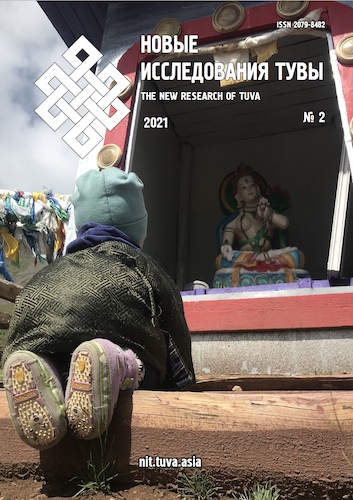Влияние буддийского мировоззрения обучающегося на обработку неродной письменной речи
DOI:
https://doi.org/10.25178/nit.2021.2.6Ключевые слова:
обучающийся, буддизм, буддийское мировоззрение, неродной язык, обработка письменной речи, чтение, извлечение из памяти, время чтения, идейная единицаАннотация
В сегодняшнем цифровом мире поиск подходов к совершенствованию обработки письменной речи имеет решающее значение для успешного освоения неродного языка. В то время как психолингвистическая литература предполагает, что фоновые знания обычно облегчают обработку письменной речи, мало известно о том, влияет ли религиозное мировоззрение, как часть знаний обучающегося, на обработку неродной письменной речи.
В настоящей статье выявленный пробел устраняется путем проведения небольшого Интернет-эксперимента в форме чтения с регулировкой скорости. Целью эксперимента является ответ на вопрос о том, аналогична ли обработка текста, связанного с буддизмом, а также религиозно нейтрального текста у буддистов со средним уровнем владения английским и у нерелигиозных с аналогичным уровнем владения. Так, в эксперименте приняли участие 20 буддийских и нерелигиозных студентов, изучающих английский язык, из российских регионов – Калмыкия, Тува и Бурятия.
Результаты эксперимента показали, что буддийское мировоззрение изучающих английский язык способствует более быстрой обработке и лучшему запоминанию связанных с буддизмом текстов на целевом языке. В статье также утверждается, что письменные материалы на изучаемом языке, касающиеся религии, необходимо обеспечить примечаниями и глоссариями для ускорения их обработки и улучшения запоминания у нерелигиозных читателей.
Библиографические ссылки
An, S. (2013) Schema Theory in Reading. Theory & Practice in Language Studies, 3(1). DOI: https://doi.org/10.4304/TPLS.3.1.130-134
Badmaev V. N., Ulanov M. S., Lamazhaa Ch. K., Bicheldey U. N., Antonov V. I. and Ochirova O. A. (2020) Russia and the Buddhist world through the eyes of the youth in Tuva, Buryatia, and Kalmykia: a sociological survey and its outcomes. The New Research of Tuva, no. 1, pp. 36–49. DOI: https://doi.org/10.25178/nit.2020.1.3
Bernhardt, E. B. (1983) Three approaches to reading comprehension in intermediate German. The Modern Language Journal, no. 67(2), pp. 111–115. DOI: https://doi.org/10.1111/j.1540-4781.1983.tb01478.x
Carreiras, M., Armstrong, B. C., Perea, M. and Frost, R. (2014) The what, when, where, and how of visual word recognition. Trends in Cognitive Sciences, no. 18(2), pp. 90–98. DOI: https://doi.org/10.1016/j.tics.2013.11.005
Crossley, S. A., Greenfield, J. and McNamara, D. S. (2008) Assessing text readability using cognitively based indices. TESOL Quarterly, no. 42(3), pp. 475–493. DOI: https://doi.org/10.1002/j.1545-7249.2008.tb00142.x
Delgado, P. and Salmerón, L. (2021) The inattentive on-screen reading: Reading medium affects attention and reading comprehension under time pressure. Learning and instruction, no. 71. DOI: https://doi.org/10.1016%2Fj.learninstruc.2020.101396
Dell, G. S. and Chang, F. (2014) The P-chain: Relating sentence production and its disorders to comprehension and acquisition. Philosophical Transactions of the Royal Society B: Biological Sciences, no. 369(1634). DOI: https://doi.org/10.1098/rstb.2012.0394
Ferreira, F. and Chantavarin, S. (2018) Integration and prediction in language processing: A synthesis of old and new. Current Directions in Psychological Science, no. 27(6), pp. 443–448. DOI: https://doi.org/10.1177%2F0963721418794491
Graesser, A. C., Singer, M. and Trabasso, T. (1994) Constructing inferences during narrative text comprehension. Psychological Review, no. 101(3)DOI: https://doi.org/10.1037/0033-295X.101.3.371
Henry, N. A. (2015) Morphosyntactic processing, cue interaction, and the effects of instruction: An investigation of processing instruction and the acquisition of case markings in L2 German. Doctoral dissertation. Pennsylvania State University.
Kekeeva, Z., Darzhinova, S. and Abdiraimova, E. (2020) Development of the reading culture in pre-service teachers amid digitalization of education. In: E3S Web of Conferences (Vol. 210, p. 18083). EDP Sciences. DOI: https://doi.org/10.1051/e3sconf/202021018083
Kuperberg, G. R. and Jaeger, T. F. (2016) What do we mean by prediction in language comprehension? Language, Cognition and Neuroscience, no. 31(1), pp. 32–59. DOI: https://doi.org/10.1080/23273798.2015.1102299
Long, D. L. and Lea, R. B. (2005) Have we been searching for meaning in all the wrong places? Defining the “search after meaning” principle in comprehension. Discourse processes, no. 39(2–3), pp. 279–298. DOI: https://doi.org/10.1207/s15326950dp3902&3_10
Marinis, T. (2010) Using on-line processing methods in language acquisition research. In: Unsworth, S. and Blom, E. (Eds.) Experimental Methods in Language Acquisition Research. Amsterdam: John Benjamins Publishing Company, 292 p. Pp. 139–162. DOI: https://doi.org/10.1075/lllt.27.09mar
Markham, P. (2001) The influence of culture-specific background knowledge and captions on second language comprehension. Journal of Educational Technology Systems, no. 29(4), pp. 331–343. https://doi.org/10.2190/15TA-GX8P-74XP-YUA1
Murray, J. D., Klin, C. M. and Myers, J. L. (1993) Forward inferences in narrative text. Journal of Memory and Language, no. 32(4), pp. 464–473. DOI: https://doi.org/10.1006/jmla.1993.1025
Navracsics, J. and Darzhinova, L. (2020) The Use of PsychToolbox-3 for Tracking Bilingual Sentence Processing and Comprehension. In: CEUR Workshop Proceedings (Vol. 2780, pp. 123-131). Aachen, RWTH Aachen University Publishing.
Nilsson, P. (2015) A Snowball Sampling Approach for Studying Digital Minority Languages. Doctoral dissertation. Swarthmore College.
Peirce, J., Gray, J. R., Simpson, S., MacAskill, M., Höchenberger, R., Sogo, H., Kastman, E., & Lindeløv, J. K. (2019) PsychoPy2: Experiments in behavior made easy. Behavior Research Methods, no. 51(1), pp. 195–203. DOI: https://doi.org/10.3758/s13428-018-01193-y
Prasad, G. and Linzen, T. (2019) Do self-paced reading studies provide evidence for rapid syntactic adaptation. Prepr. PsyArXiv. DOI: https://doi.org/10.31234/osf.io/9ptg4
Riley, G. L. and Lee, J. F. (1996) A comparison of recall and summary protocols as measures of second language reading comprehension. Language testing, no. 13(2), pp. 173–189. DOI: https://doi.org/10.1177%2F026553229601300203
Roberts, L. and Liszka, S. A. (2013) Processing tense/aspect-agreement violations on-line in the second language: A self-paced reading study with French and German L2 learners of English. Second Language Research, no. 29(4), pp. 413–439. DOI: https://doi.org/10.1177/0267658313503171
Rumelhart, D. (1980) Schemata: The Building Blocks of Cognition. In: Spiro, R., Bruce, B. and Brewer, W., Eds., Theoretical Issues in Reading Comprehension, Erlbaum Associates, Mahway. Pp. 33–58. DOI: https://doi.org/10.4324/9781315107493
Smith, N. J. and Levy, R. (2013) The effect of word predictability on reading time is logarithmic. Cognition, no. 128(3), pp. 302–319. DOI: https://doi.org/10.1016/j.cognition.2013.02.013
Veldre, A. and Andrews, S. (2018). Beyond cloze probability: Parafoveal processing of semantic and syntactic information during reading. Journal of Memory and Language, 100, 1-17. DOI: https://doi.org/10.1016/j.jml.2017.12.002
White, A. L., Palmer, J. and Boynton, G. M. (2020) Visual word recognition: Evidence for a serial bottleneck in lexical access. Attention, Perception, & Psychophysics, no. 82(4), pp. 2000–2017. DOI: https://doi.org/10.3758/s13414-019-01916-z
Загрузки
Опубликован
Выпуск
Раздел
Как цитировать
Darzhinova L. V. The influence of language learner’s Buddhist background on non-native written language processing.
New Research of Tuva, 2021, no. 2, pp. 67-78. DOI: https://www.doi.org/10.25178/nit.2021.2.6
Для цитирования
Darzhinova L. V. The influence of language learner’s Buddhist background on non-native written language processing //
Новые исследования Тувы. 2021. № 2. С. 67-78. DOI: https://www.doi.org/10.25178/nit.2021.2.6
Лицензия

Это произведение доступно по лицензии Creative Commons «Attribution-NonCommercial» («Атрибуция — Некоммерческое использование») 4.0 Всемирная.

Автор (лицензиар) произведения предоставляет простую (неисключительную) лицензию на использование редакцией (лицензиатом) произведения науки, который заключается в упрощённом порядке (открытая лицензия), согласно ст. 1286.1. «Открытая лицензия на использование произведения науки, литературы или искусства» Гражданского кодекса Российской Федерации.
В нашем издании публикуемые материалы доступны по лицензии Creative Commons «Attribution-NonCommercial» («Атрибуция — Некоммерческое использование») — CC BY-NC.
Т. к. лицензия открытая, автор имеет право разместить статью после ее выхода на своем сайте, читатель может скопировать и разместить на своих персональных ресурсах, в том числе в виде выдержек, конспектов, но:
а) обязательно должно быть указано ФИО автора, неизмененное название статьи и гиперссылка на первоисточник (журнал «Новые исследования Тувы»),
б) размещающий не имеет права брать деньги за доступ к этому материалу или каким бы то ни было образом давать преимущество одним читателям над другими,
в) при перепечатке автором текста статьи без значительных изменений (если сохраняется 30% текста или более) должно быть указано, что первая редакция статьи вышла в журнале «Новые исследования Тувы» и сделана соответствующая ссылка.
Лицензия действует по всему миру, длится в течение срока авторских прав на произведение, является неотзывной.





